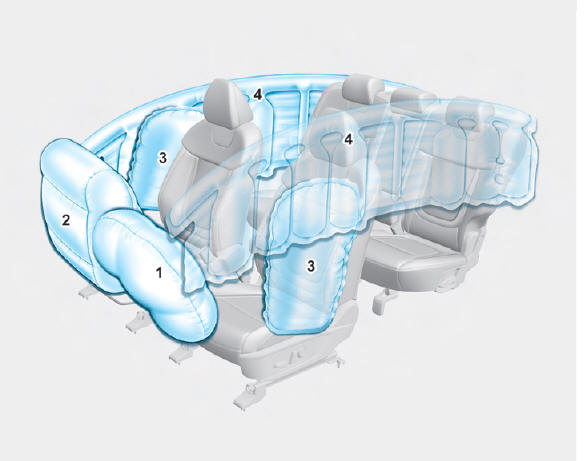Hyundai Tucson: Air bag - supplemental restraint system

- Driver's front air bag
- Passenger's front air bag
- Side air bag
- Curtain air bag
The vehicles are equipped with a Supplemental Air Bag System for the driver's seat and front passenger's seats.
The front air bags are designed to supplement the three-point seat belts. For these air bags to provide protection, the seat belts must be worn at all times when driving.
You can be severely injured or killed in an accident if you are not wearing a seat belt.
Air bags are designed to supplement seat belts, but do not replace them. Also, air bags are not designed to deploy in every collision. In some accidents, the seat belts are the only restraint protecting you.
WARNING
AIR BAG SAFETY PRECAUTIONS
ALWAYS use seat belts Child Restraint Systems - every trip, every time, everyone! Even with air bags, you can be seriously injured or killed in a collision if you are improperly belted or not wearing your seat belt when the air bag inflates.
NEVER place a child in any Child Restraint System or booster seat in the front passenger seat, unless the air bag is deactivated.
An inflating air bag could forcefully strike the infant or child causing serious or fatal injuries.
ABC - Always Buckle Children under age 13 in the back seat. It is the safest place for children of any age to ride. If a child age 13 or older must be seated in the front seat, he or she must be properly belted and the seat should be moved as far back as possible.
All occupants should sit upright with the seatback in an upright position, centered on the seat cushion with their seat belt on, legs comfortably extended and their feet on the floor until the vehicle is parked and the vehicle is turned off. If an occupant is out of position during an accident, the rapidly deploying air bag may forcefully contact the occupant causing serious or fatal injuries.
You and your passengers should never sit or lean unnecessarily close to the air bags or lean against the door or center console.
Move your seat as far back as possible from front air bags, while still maintaining control of the vehicle. The U.S. National Highway Traffic Safety Administration (NHTSA) recommends that drivers allow at least 10 inches (25 cm) between the center of the steering wheel and the chest.
- Where are the air bags?
- How does the air bags system operate?
- Occupant Classification System (OCS)
- Why didn't my air bag go off in a collision?
- SRS care
READ NEXT:
 Where are the air bags?
Where are the air bags?
Driver's and passenger's front air
bags
Driver's front air bag
Passenger's front air bag
Your vehicle is equipped with a
Supplemental Restraint System (SRS)
and lap/shoulder belts at both the driver
and passenger seating positions.
 How does the air bags system operate?
How does the air bags system operate?
The SRS consists of the following
components:
Driver's front air bag module
Passenger's front air bag module
Side air bag modules
Curtain air bag modules
Retractor pre-tensioner
Air bag warning light
SRS contr
 Occupant Classification System (OCS)
Occupant Classification System (OCS)
Your vehicle is equipped with an
Occupant Classification System (OCS) in
the front passenger's seat.
Main components of the Occupant
Classification System
A detection device located within the
front passenger seat cushion.
Electronic
SEE MORE:
 Curtain Air Bag (CAB)
Curtain Air Bag (CAB)
Components Location
Curtain Air Bag (CAB)
Removal
Disconnect the batteiy negative terminal.
WARNING
After disconnecting the cables, wait at least 3 minutes.
Remove the roof trim.
(Refer to Body - "Roof Trim Assembly"
 Roll rod bracket
Roll rod bracket
Remove the engine room under cover.
(Refer to Engine and Transaxle Assembly - "Engine Room Under Cover")
Remove the roll rod bracket (A).
Tightening torque :
Bolt (B): 107.9 - 127.5 N.m (11.0 - 13.0 kgf.m, 79.6 - 94.0 lb-ft)
Information
- Home
- Hyundai Tucson - Fourth generation (NX4) - (2020-2023) - Owner's Manual
- Hyundai Tucson - Fourth generation (NX4) - (2020-2023) - Workshop Manual